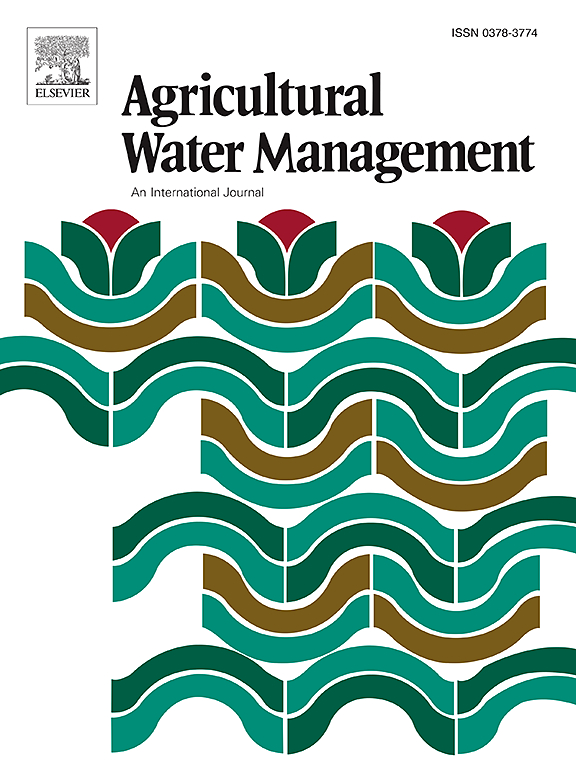了解气候多变性及其对玉米产区干旱发生的影响:来自中国北方的证据
IF 5.9
1区 农林科学
Q1 AGRONOMY
引用次数: 0
摘要
据预测,全球变暖将加剧未来的干旱,这将对中国的玉米种植产生重大影响。因此,我们利用耦合模式相互比较项目第 6 阶段(CMIP6)在两种共享社会经济路径(SSP245 和 SSP585)下的降尺度输出结果,研究了相对于基线期(1981-2014 年),未来三个时间段(2020-2039 年、2040-2069 年和 2070-2099 年)玉米生长期(MGP)的气候模式变化及其影响。标准化降水蒸散指数(SPEI)按月、3 个月和 6 个月的时间尺度进行计算,以监测未来短期和长期的干旱状况。结果表明,在 SSP245 条件下,2030s、2060s 和 2090s 全区平均气温分别上升 0.63-1.90°C、0.85-2.13°C 和 1.21-2.42°C;在 SSP585 条件下,2030s、2060s 和 2090s 全区平均气温分别上升 1.42-2.76°C、1.84-3.07°C 和 2.01-3.57°C。与基期相比,预计在 SSP245 和 SSP585 条件下,MGP 期间的降水量在 2030 s 至 2090 s 期间将分别增加 22.71-97.14 mm 和 29.92-98.40 mm。我们的结果还表明干旱发生的区域差异,西北干旱区(NWAR)、内蒙古地区(IMR)和中国东北地区(NEC)经历了不同程度的干旱。轻度干旱持续时间预计将增加 5.6 %-8.5 %(SSP245)和 5.7 %-9.2 %(SSP585),中度干旱持续时间预计将增加 3.8 %-8.8 %(SSP245)和 4.2 %-9.9 %(SSP585)。在西北地区,预计从2030年到2090年,轻度干旱将分别增加24.3%-30.5%(SSP245)和27.2%-33.3%(SSP585),中度干旱将分别增加13.1%-25.6%(SSP245)和18.9%-31.5%(SSP585)。未来预测还表明,整个研究区域的轻度、中度和重度干旱的严重程度将显著增加,西北部地区的增幅最大。本研究的结果为中国北方地区水资源的有效利用、适应性灌溉策略以及抗旱作物品种的需求提供了有地区针对性的宝贵见解。本文章由计算机程序翻译,如有差异,请以英文原文为准。
Understanding climate variability and its impact on drought occurrences in maize producing regions: Evidence from north of China
Global warming is projected to increase future droughts that will have a significant impact on maize cultivation in China. Therefore, we studied the changing climate patters and its impact during the maize growth period (MGP) using the downscaled outputs from the Coupled Model Intercomparison Project Phase 6 (CMIP6) under two Shared Socioeconomic Pathways (SSP245 and SSP585) for the future period in three timelines (2020–2039; 2040–2069; and 2070–2099) relative to the baseline period (1981–2014). The Standardized Precipitation Evapotranspiration Index (SPEI) was calculated on monthly, 3-monthly, and 6-monthly timescales to monitor the short and long-term future drought conditions during the MGP in the north of China. Our results show an increase of mean temperature by 0.63–1.90 °C, 0.85–2.13 °C, and 1.21–2.42 °C under SSP245 and 1.42–2.76 °C, 1.84–3.07 °C, and 2.01–3.57 °C under SSP585 in 2030 s, 2060 s, and 2090 s across the region during MGP. The precipitation during MGP is projected to increase from 22.71–97.14 mm and 29.92–98.40 mm from 2030 s to 2090 s under SSP245 and SSP585, respectively, relative to the base period. Our results also indicate regional variations in drought occurrences, with Northwestern Arid Region (NWAR), Inner Mongolia Region (IMR), and Northeast China (NEC) experiencing differing degrees of drought intensity. The duration of mild droughts is projected to increase by 5.6 %–8.5 % (SSP245) and 5.7 %–9.2 % (SSP585) and moderate droughts are expected to rise by 3.8 %–8.8 % (SSP245) and 4.2 %–9.9 % (SSP585). In the NWAR, mild droughts are projected to increase by 24.3 %–30.5 % (SSP245) and 27.2 %–33.3 % (SSP585) and moderate droughts increasing by 13.1 %–25.6 % (SSP245) and 18.9 %–31.5 % (SSP585) from the 2030 s to the 2090 s, respectively. Future projections also suggest a significant increase in the severity of mild, moderate, and severe droughts across the study area, with northwestern regions exhibiting the highest increase. The results of this study provide region specific valuable insights for efficient utilization of water resources, adaptive irrigation strategies, and need for drought-resistant crop varieties in the north of China.
求助全文
通过发布文献求助,成功后即可免费获取论文全文。
去求助
来源期刊

Agricultural Water Management
农林科学-农艺学
CiteScore
12.10
自引率
14.90%
发文量
648
审稿时长
4.9 months
期刊介绍:
Agricultural Water Management publishes papers of international significance relating to the science, economics, and policy of agricultural water management. In all cases, manuscripts must address implications and provide insight regarding agricultural water management.
 求助内容:
求助内容: 应助结果提醒方式:
应助结果提醒方式:


